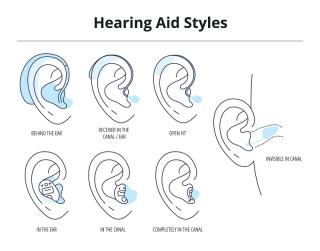Different Hearing Aid Options

3 min read
Discovering the ideal hearing aid for you can feel overwhelming. The right choice depends on your type of hearing loss, lifestyle, and aesthetic preferences. Getting professionally fitted hearing aids at a clinic offers the widest range of models and expert customization options.
Advantages:
Advantages:
Advantages:
Advantages:
Advantages:
Understanding Hearing Aid Types
The two basic classifications for hearing aids include in-the-ear and behind-the-ear.- In-the-ear (ITE) devices, commonly known as “invisible hearing aids,” fit snugly within the ear canal.
- Behind-the-ear (BTE) devices perch behind or atop the outer ear. Sound travels down into the ear canal through tubing connected to custom-fit earmolds or open-fit domes.
ITE Hearing Aids
Invisible-in-the-canal (IIC) and completely-in-the-canal (CIC) devices rank high in discreetness. IICs sit deep within the ears and can be removed using a tiny pull-out string. CICs, though similar, sit less deeply within the ears.Advantages:
- Remarkably discreet
- Superior sound quality due to their in-ear placement
- Prone to ear wax and moisture damage
- Frequent battery changes required
- Dexterity challenges due to their petite size
Advantages:
- Discreet design with added benefits like directional microphones
- Able to cater to a broader hearing loss spectrum
- Longer battery life
- Vulnerable to ear wax and moisture
- Possible challenges with wireless connectivity due to size
Advantages:
- Easier handling due to size
- Packed with user controls and connectivity features
- Less discreet
- Can make the ears feel plugged
BTE Hearing Aids
Receiver-in-the-ear (RITE) or receiver-in-canal (RIC) devices dominate the market due to their exceptional sound quality and design. They split the speaker from the main hearing aid body, with the speaker fitting into the ear and the body resting behind it.Advantages:
- Rechargeable battery options
- High chances of wireless device compatibility
- Enhanced technological features, including AI
- Potential handling challenges with smaller mini-RITEs
- Speakers can be vulnerable to damage
Advantages:
- Less susceptible to moisture damage
- Packed with advanced technology and wireless device connectivity
- Replaceable custom-fit earmold
- Less discreet
- Possible constraints for eyeglass wearers
Finding Your Perfect Match
When considering your options, be sure to choose hearing aids with certain in-demand features, such as rechargeable batteries, aesthetic appeal, in-built Bluetooth, and telecoil enablement. Before making your purchase, follow these steps:- Consult a doctor to diagnose your hearing issues.
- Get a referral for a reputable audiologist.
- Opt for a trial period.
- Consider future adjustments and maintenance.
- Check for warranties and avoid misleading claims.
- Discuss pricing, features, and your specific needs with your audiologist.
